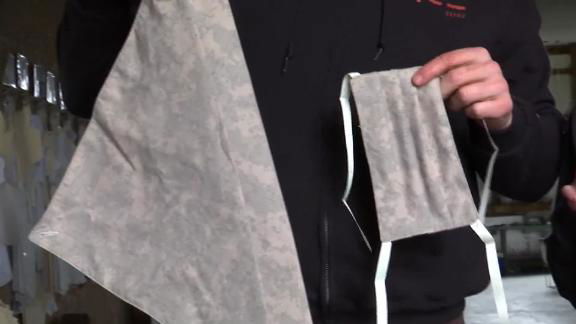Face masks could be part of the answer

Should everyone be wearing masks?
The Centers for Disease Control and Prevention says no. China, South Korea, Taiwan, Hong Kong and the Czech Republic say yes. In some parts of China, it is mandatory to wear a mask when in public. Those caught outside not wearing a mask are stopped by police and may be fined or even arrested. In South Korea, Taiwan and Hong Kong, health authorities advise everyone to wear a mask in the presence of others, especially in crowded places (i.e., riding the subway).
However, here in the United States, the CDC guidance continues to be, “If you are NOT sick: you do not need to wear a face mask unless you are caring for someone who is sick (and they are not able to wear a face mask).” The CDC goes on to say that “face masks may be in short supply and they should be saved for caregivers.” In line with this guidance, the US surgeon general tweeted in February, “Seriously people – STOP BUYING MASKS!”
But as Covid-19 cases continue to climb in the United States, an increasing number of health experts, such as the director of Johns Hopkins Center for Health Security, Tom Inglesby, advise wearing masks as a means to prevent the proliferation of the virus. Additionally, the Trump administration is now reconsidering the nation’s stance on wearing masks in public as a preventative measure. Anthony Fauci, the top US infectious disease doctor, said that the White House is in “very active discussion” about whether to recommend the use of masks by citizens in some circumstances.
Are masks really unnecessary or are there just not enough?
Since we don’t have enough face masks, we absolutely have to prioritize providing masks to those with the highest risk of infection, such as health care workers and first responders. But we, as a nation, should also be honest about whether the current guidance for healthy citizens not to use masks in public is really supported by the science or is just an attempt to prevent panic-buying and to preserve a limited resource for high risk groups.
The reality is that the proper use of face masks by citizens when they are in public spaces can benefit public health. (It should be noted that experts warn that if a face mask is worn improperly the wearer may be more susceptible to the virus, as they may touch their face more frequently.)
The US should strongly consider more widespread use of this protective gear, in addition to hand hygiene and social distancing.
What does the science tell us about masks?
We know that the virus is spread primarily by respiratory droplets produced when an infected person coughs or sneezes. Droplets can also be generated by talking, laughing, singing or just exhaling. They can land in the mouths or noses of people who are nearby or be inhaled into the lungs, which is why people have been asked to stay at least 6 feet away from each other.
It’s also possible for infected droplets to be transferred to surfaces and then spread by contact when another person touches the surface and then touches their eyes, nose or mouth. This is why public health officials have emphasized frequent hand-washing and cleaning of surfaces.
It has been suggested by institutions such as the Mayo Clinic that when someone infected with a respiratory viral illness wears a surgical mask it protects others from getting infected because the masks catch the droplets and keep them from reaching other people. But we have also learned that individuals can be infected with the coronavirus and be contagious even when they have no symptoms. In fact, it is likely that in some outbreaks, a significant number of individuals were infected by those with no symptoms who were unknowingly spreading the virus. Could they have minimized spread of the virus if they had been using face masks before they felt sick?
Also, let’s be realistic about how easy it is to be less than 6 feet away from others when we’re at the grocery store or taking public transportation. Would it not be worth having an additional layer of protection? While brief encounters with others involving minimal interaction may not be high risk, why have we emphasized hand-washing and disinfecting surfaces after those interactions so much more than face masks when this virus is spread largely through respiratory droplets?
The scientific evidence is mixed regarding the effectiveness of masks at containing viral spread when worn by healthy people.
Some studies have not found a benefit. However, many were limited because the subjects didn’t wear the masks as often as they were supposed to. In contrast, the CDC’s own 2017 guidance on how to prevent pandemic flu in the community stated that “the use of face masks by well persons might be beneficial in certain situations (e.g., when persons at high risk for influenza complications cannot avoid crowded settings or parents are caring for ill children at home). Face mask use by well persons also might reduce self-inoculation (e.g., touching the nose with the hand after touching a contaminated surface).”
The same logic should apply to prevent the spread of the coronavirus.
What’s more, we can look at the measures shown to be effective to slow community transmission of SARS in 2003 as an example of steps to be taken today. A large study in Hong Kong found that wearing a face mask regularly in public places, frequent hand-washing and disinfecting one’s home were all effective in limiting the spread of that virus in the community.
Another study conducted in Beijing found that always wearing a mask when going out was associated with a 70% reduction in risk of being diagnosed with SARS during the outbreak compared with never wearing a mask.
That brings us back to the shortage. If wearing masks could help reduce the spread of the virus, how do we get more masks?
Taiwan offers a helpful model. Like the United States, Taiwan has seen an increased demand for face masks and disruptions in the supply chain. Prior to the pandemic, the majority of masks sold in Taiwan were manufactured elsewhere, with over 90% coming from China. In the past month, the Taiwanese government aggressively ramped up private manufacturing so that Taiwan can now make millions of masks per day and has enough N95 masks and hazmat suits for all their medical personnel.
The Taiwanese government also made it easier for the general public to buy surgical masks, creating a centralized online system to ration and ship them (each mask is sold for less than $0.25).
Through this system, more than 2.3 million people were given the ability to buy seven million masks over the course of a single week. Of note, Taiwan, a densely populated country of 23 million people about 80 miles off the coast of China, has had only 322 confirmed infections and five deaths due to Covid-19 as of March 31.
And Taiwan has, for the most part, not closed schools or businesses and has not implemented a lockdown.
In an effort to protect citizens with minimal disruption to everyday life, the US government should use every possible authority, leverage and funding source to rapidly manufacture or acquire more masks and ensure they are distributed in a rational way nationwide to the highest risk groups first. But then perhaps we should turn our attention to helping the general public get access to masks. If Taiwan can ratchet up private sector manufacturing in one month, the United States most certainly can, too.
What can we do in the meantime?
While there is limited research on the effectiveness of homemade masks made from household materials to block droplet transmission, some studies show that homemade masks are better than no mask. Next time you go to the grocery store, you might want to bring with you some homemade Personal Protective Equipment.



